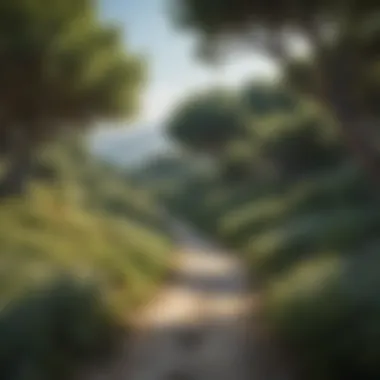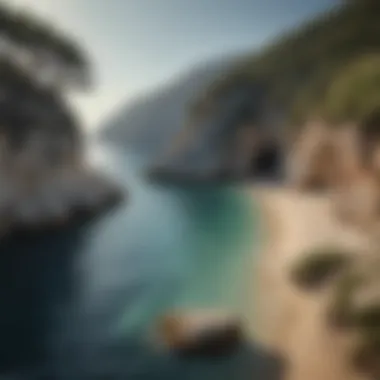Exploring Cephalonia's Natural Wonders and Culture


Intro
Cephalonia, the largest of the Ionian Islands in Greece, is a place where nature and culture intertwine. It boasts an impressive array of geological formations and ecosystems. This creates a unique environment that is both beautiful and meaningful. The island’s cultural legacy, shaped by centuries of history, reflects the diverse influences that have settled here. This article seeks to delve into these aspects, providing thorough insight into Cephalonia's natural wonders and cultural significance.
Research Overview
The examination of Cephalonia addresses several critical aspects. First, it highlights the island's unique geological features, which contribute to its varied landscape. Second, it discusses the rich biodiversity found in its flora and fauna. Furthermore, the cultural significance of historical landmarks and traditions is considered.
In exploring these themes, the article aims to present a detailed understanding of the island’s ecological balance and historical legacy.
Summary of Key Findings
- Geological Diversity: Cephalonia features a range of geological formations including limestone cliffs, caves, and beaches.
- Biodiversity: The island is home to various species of plants and animals, many of which are endemic.
- Cultural Heritage: Historical sites like the Castle of Saint George and traditional villages reflect Cephalonia’s rich past.
Research Objectives and Hypotheses
The main objectives are to:
- Analyze the geological structures and their impact on local ecology.
- Explore the relationship between the natural environment and cultural practices on the island.
- Assess the current environmental challenges faced by Cephalonia and their implications for the future.
Methodology
To understand Cephalonia's intricate natural and cultural landscape, a systematic approach is essential. The method includes both qualitative and quantitative analysis to ensure a comprehensive view.
Study Design and Approach
This research adopts a mixed-methods design, combining field studies with literature review. Field studies allow for direct observation and data collection. Literature review provides background and contextual information.
Data Collection Techniques
Data collection involves:
- Field Surveys: Observations of geological formations and ecosystems.
- Interviews: Discussions with local experts on cultural significance.
- Archival Research: Examination of historical documents to understand past influences on the island's culture.
"Understanding Cephalonia is essential to appreciate its beauty and complexity, revealing layers of history woven into its natural landscape."
In closing, this research sets the stage for a detailed examination of Cephalonia. From its geological wonders to its cultural richness, the island is a subject deserving of thorough exploration.
Preface to Cephalonia
Cephalonia is not just another island in Greece; it is a testament to nature's artistry and humanity's historical journey. As the largest of the Ionian Islands, its geographical diversity ranges from lush forests to rugged mountains and serene beaches. Understanding Cephalonia requires a look into its natural and cultural dimensions, laying the foundation for a deeper appreciation of what the island has to offer.
The significance of Cephalonia in this article lies in its intricate interplay between ecology and human culture. This introduction sets the stage for exploring complex themes such as the impact of geological features on local ecosystems and the role of history in shaping contemporary society on the island. By examining these elements, readers can appreciate how Cephalonia's unique environment influences its heritage and current societal trends.
Geographical Overview
Cephalonia features a varied landscape shaped by both tectonic activity and natural erosion. Its topography includes mountain ranges, notably Mount Ainos, which is the highest point on the island and houses a national park. This park is noted for its rich biodiversity, showcasing a range of flora and fauna unique to the region. The island's coastline is adorned with pristine beaches, such as Myrtos and Antisamos, which are often cited among the most beautiful in Greece.
The climate is Mediterranean, characterized by hot, dry summers and mild, wet winters. This climate supports a diverse range of ecosystems that foster both terrestrial and marine biodiversity, providing an essential habitat for numerous species. Understanding these geographical features is crucial for grasping Cephalonia's ecological importance and the role it plays in local culture and tourism.
Historical Context
Cephalonia's history is as multifaceted as its landscape. The island has been influenced by various civilizations, from ancient Greeks to the Venetians. Each period left behind legacies that shape the modern identity of the island. The ancient ruins, such as those found in Samis, echo stories of past glories and cultural exchanges.
During the Venetian period, from the 15th to the 18th centuries, Cephalonia experienced economic growth and architectural development. The influence is visible in the towns and structures that dot the landscape today. This historical context is important when considering contemporary social dynamics and local governance. In the modern context, historical awareness plays a role in local pride and identity, making history a living narrative woven into daily life.
Cultural Influence
Cephalonia's culture is a tapestry woven with threads of tradition, religion, and artistic expression. The island is renowned for its music and dance, particularly the serenades sung in the streets of Argostoli, which reflects the blend of local traditions and foreign influences. Festivals celebrating religious and agricultural events are regular occurrences, showcasing the island's communal bonds.
The local cuisine is another integral aspect of its cultural identity. Traditional dishes are often based on locally sourced ingredients, celebrating the island's natural bounty. Through these culinary practices, the residents maintain a deep connection to their land and its history.
In summary, Cephalonia presents a rich field for study, encompassing various natural, historical, and cultural dimensions. This introduction serves as an essential guide to understanding the complexities that define the island and its significance in the broader narrative of Greece. The ensuing sections will delve deeper into each aspect, uncovering the distinctive attributes that make Cephalonia a vital part of Greece's ecological and cultural landscape.


Geology of Cephalonia
The geology of Cephalonia is a critical aspect of its identity, offering insights into its natural history, ecological diversity, and attraction for researchers and visitors alike. Understanding the geological formations and processes helps us comprehend not only the island's landscape but also its rich biodiversity and cultural heritage. The island's geological narrative is primarily shaped by its tectonic activity, varying rock formations, and unique karst landscapes. All these elements contribute significantly to the overall ecosystem and have implications for environmental conservation efforts.
Tectonic Activity
Cephalonia is situated at the convergence of the Eurasian and African tectonic plates, which significantly influences its geological features. This tectonic setting accounts for the island's seismic activity and contributes to its uplift and subsidence patterns. The history of tectonic movements has produced various geological structures, such as mountains, valleys, and fault lines. The most notable tectonic event in recent history was the 1953 earthquake, which reshaped many aspects of the island's infrastructure and environment.
The tectonic activity also plays a role in creating essential mineral resources found on the island, supporting various local industries. For researchers and geologists, Cephalonia provides a unique laboratory for studying plate tectonics and the resulting geological phenomena.
Rock Formations
Cephalonia's landscape is diverse, showcasing a variety of rock formations. The predominant rocks in the region are limestone, dolomite, and sandstone. Limestone, in particular, forms the backbone of many dramatic cliffs and stunning coastal views that characterize the island.
The famous Mount Ainos, the highest peak on the island, is primarily composed of limestone. Its unique geological structure contributes to its rich biodiversity and ecosystems. Besides, the formations present a variety of colors, textures, and eroded features that capture the interest of geologists and tourists alike.
Visitors often explore several geological sites, including Assos Castle, which is built atop rocky outcrops, and the spectacular Melissani Cave, where the sedimentary processes have created a captivating underground lake. These formations offer a glimpse into the geological history that shaped the island.
Karst Landscapes
Karst landscapes are another significant aspect of Cephalonia's geology. The dissolution of limestone in water has created these unique formations characterized by sinkholes, underground streams, and caves. This process has resulted in a striking surface topology that is both unique and valuable for ecological studies.
Melissani Cave is a prime example of a karst landscape, featuring a partially collapsed roof that allows sunlight to illuminate the turquoise waters below. Such karst features support varied ecosystems that contribute to the island's biodiversity. The network of caves and underground rivers plays a crucial role in groundwater recharge, affecting local water supplies.
"Geology is the study of the earth and its processes; in Cephalonia, these processes tell a story of change and resilience."
For further understanding of geology, you may explore resources like Britannica and Wikipedia.
Biodiversity in Cephalonia
Biodiversity in Cephalonia is a treasure trove of both natural beauty and ecological significance. The island's varied landscapes create unique habitats that support a rich array of plant and animal life. Understanding the diversity in Cephalonia is essential for appreciating its ecological importance and cultural heritage. The island's biodiversity contributes to its appeal as a tourist destination, while also playing a crucial role in local ecosystems and community livelihoods.
Flora of Cephalonia
Cephalonia boasts a diverse range of flora, adapting well to the Mediterranean climate. This includes both endemic species and those imported by human activity. The island's plant life showcases a mosaic of vegetation types, from dense forests to rocky outcrops. Notable flora includes:
- Olive trees: These iconic trees thrive in the island's climate and are central to its agricultural landscape.
- Pine forests: Essential for soil stabilization and as a habitat for various species.
- Wildflowers: Species like the endemic Cephalonia orchid add to the island's scenic beauty.
Conservation of these plants is vital for maintaining the ecological balance and ensuring sustainable tourism practices.
Fauna of Cephalonia
Cephalonia's fauna is remarkably rich, with various species that depend on its unique habitats. The island is home to both land and marine life, contributing to its ecological diversity. Key aspects of its fauna include:
- Bird species: Many migratory birds find sanctuary in Cephalonia, particularly around wetlands.
- Marine life: The surrounding sea supports various fish species, making it an important fishing ground.
- Terrestrial mammals: The island hosts species such as the common Mediterranean tortoise, which is a focus of conservation efforts.
Effective management and protection of these species are crucial for preserving the island's ecological integrity.
Protected Areas
To safeguard its diverse ecosystems, Cephalonia has established several protected areas. These areas are critical for conservation, scientific research, and education. They include:
- Kefalonia National Park: This park protects many habitats and provides a refuge for native species.
- Nature reserves: These offer safe havens for wildlife and promote biodiversity research.
- Marine protected areas: These areas aim to conserve the rich underwater ecosystems.
By maintaining these protected regions, Cephalonia can ensure the survival of its unique biodiversity, which benefits not only the environment but also the local communities whose livelihoods depend on these natural resources.
Ecological Challenges
The ecological challenges faced by Cephalonia are critical when considering both its natural wonders and its cultural significance. The island's unique ecology is under threat from various sources, making understanding these challenges essential for preservation efforts. Addressing ecological issues not only protects biodiversity but also sustains local culture and the economy. This section presents a detailed overview of the main ecological challenges confronting Cephalonia, emphasizing the need for action and awareness.
Environmental Degradation
Environmental degradation on Cephalonia manifests through multiple processes, including deforestation, pollution, and unsustainable tourism. Urbanization has led to the destruction of natural habitats. Other factors, such as agricultural practices, contribute to the loss of biodiversity. For instance, the introduction of inappropriate farming techniques has degraded soil and water quality.
The most significant areas affected include coastal zones and forests. Encroachment by development projects threatens critical habitats for many native species. The impact of pollution from wastewater and plastic waste is also alarming. As a result, local ecosystems are becoming fragile.


Preserving the island's natural beauty requires immediate action.
Invasive Species
Invasive species pose another major ecological challenge for Cephalonia. These organisms often outcompete native species, disrupting local ecosystems. For example, the introduction of the common ragweed has resulted in significant competition with native plants, altering local habitats.
Moreover, invasive marine species threaten Cephalonia’s marine biodiversity. Species such as the lionfish affect coral reef ecosystems, which are among the most diverse habitats. The introduction of invasive species can result from global trade and travel, reflecting a growing concern worldwide.
Mitigating the impact of invasive species involves monitoring and effective management strategies. Local authorities, along with conservationists, must develop initiatives focused on removal or control of invasives to prevent them from undermining native ecosystems.
Conservation Efforts
Conservation efforts on Cephalonia aim to restore and protect the island's unique ecosystems. Various organizations, including local NGOs and international bodies, are spearheading initiatives for raising awareness about ecological issues. These efforts include habitat restoration, creating protected areas, and promoting sustainable tourism practices.
Key strategies involve the following:
- Establishing marine protected areas to safeguard marine life.
- Educating locals and tourists about sustainable practices to minimize environmental impact.
- Enacting legislation to control pollution and land development.
These initiatives reflect a growing recognition of the importance of sustainability. By engaging the community and stakeholders, conservation efforts are more likely to succeed.
“Protecting Cephalonia's ecosystems is essential not only for wildlife but also for preserving cultural heritage and community identity.”
In summary, addressing ecological challenges is vital for the future of Cephalonia. Public engagement, effective management, and international collaboration will be necessary to tackle these pressing issues.
Cultural Heritage and Local Ecosystems
Cultural heritage in Cephalonia is deeply intertwined with its local ecosystems. Understanding this connection is crucial to grasping the island's identity. Traditional practices often follow the rhythms of nature, shaped by the unique environmental context of the region. This connection provides numerous benefits, from sustaining local economies to preserving biodiversity.
Traditional Practices
The people of Cephalonia have long relied on the land and sea. Agriculture, fishing, and local crafts shaped their way of life.
- Agriculture: The cultivation of unique local crops, such as local olives and grapes, reflects not only the soil's fertility but also centuries of knowledge passed down through generations. The island's terraced landscapes show how communities adapted to its rugged terrain.
- Fishing: Traditional fishing practices also demonstrate respect for marine life. Fishermen often use methods that promote sustainability, ensuring that fish populations remain healthy.
- Crafts: The creation of artisanal products, from pottery to textiles, incorporates natural materials found locally. These crafts are not just economically beneficial but express the island's artistic heritage.
These practices are more than sustenance; they represent a way to harmonize human needs with nature’s offerings.
Modern Developments
As Cephalonia evolves, modern developments have begun to reshape its cultural landscape. However, these changes present challenges and opportunities:
- Tourism Growth: The rise of tourism has brought both economic benefits and environmental pressure. While it provides income, it also threatens traditional lifestyles and ecosystems.
- Renewable Energy: Some initiatives focus on sustainable energy production, aiming to reduce the island’s carbon footprint while respecting local traditions.
- Cultural Festivals: Events celebrating local culture now attract global attention. These festivals foster community pride and encourage cultural exchange.
Modern developments in Cephalonia must balance progress with preservation to support both the economy and the environment.
Community Involvement
Community involvement is crucial for preserving Cephalonia’s cultural heritage and local ecosystems.
- Education: Local schools engage students in learning about sustainability and heritage. This education creates a sense of responsibility towards their environment.
- Conservation Programs: Residents often participate in local conservation programs. These initiatives help protect and restore habitats, ensuring biodiversity is preserved while maintaining traditions.
- Collaboration with Organizations: Partnerships with environmental organizations strengthen community efforts in protection and education. Collaborative projects can lead to innovative solutions that benefit both culture and nature.
"The intertwining of traditions and ecosystems forms the backbone of Cephalonia's identity, shaping its future."
Tourism and Economic Impacts
Tourism plays a crucial role in the economy of Cephalonia. The island attracts visitors from all over the world, drawn by its stunning landscapes and rich cultural history. This influx of tourists not only generates revenue but also creates jobs and stimulates local businesses. However, with tourism comes a range of impacts that need careful management.
Tourist Attractions
Cephalonia is home to many diverse and captivating tourist attractions. Some of the most notable include:
- Melissani Cave: A breathtaking underground lake that enchants visitors with its blue waters and unique geology.
- Myrtos Beach: Renowned for its striking beauty, this beach is one of the most photographed locations in Greece.
- Assos village: This quaint village offers charming architecture and stunning views, along with a rich history tied to the island.
The tourist attractions of Cephalonia emphasize the island’s natural beauty and its historical significance. Such spots significantly contribute to the overall tourism appeal.


Economic Contributions
Tourism in Cephalonia contributes significantly to the local economy. The revenue generated supports various sectors, including:
- Hospitality: Hotels, resorts, and restaurants thrive due to the steady stream of visitors.
- Transportation: Local taxi services, car rentals, and ferries benefit from increased demand during peak seasons.
- Local Craftsmanship: Many tourists seek local crafts and products, providing income for artisans.
The economic contributions are evident not just in direct revenue but also in the associated benefits such as infrastructure improvements and enhanced public services to accommodate tourists.
Balancing Tourism and Conservation
While tourism is economically beneficial, it also poses challenges for environmental conservation. Overcrowding can lead to:
- Degradation of Natural Resources: Popular sites may suffer from erosion and pollution, affecting the landscape.
- Pressure on Wildlife: Increased activity can disturb local wildlife habitats, threatening biodiversity.
To counteract these impacts, community initiatives are essential. Strategies include:
- Promoting sustainable tourism practices that educate visitors and locals alike.
- Implementing visitor limits at sensitive ecological sites to ensure their preservation.
- Encouraging eco-friendly accommodations and attractions.
"Sustainable tourism is a way for us to reconcile economic growth with the need to protect the unique natural environment of Cephalonia."
Finding a balance between promoting tourist attractions and conserving the environment is vital. This ensures that Cephalonia can continue to delight visitors while safeguarding its natural and cultural heritage for future generations.
Future Prospects for Cephalonia
The future of Cephalonia embodies a pivotal moment in its evolutionary journey, intertwining ecological integrity with human advancement. This section delves into sustainable development, research initiatives, and community engagement as critical components that will shape Cephalonia's trajectory. Modern challenges and opportunities must guide decision-making processes. Elevating the dialogue around these topics will not only attract scholarly attention but encourage policy-making conducive to balancing progress with preservation.
Sustainable Development Initiatives
Sustainable development initiatives on Cephalonia focus on maintaining ecological health while fostering economic growth. Local authorities and organizations emphasize systems that respect environmental limits while enhancing community well-being.
- Renewable Energy Projects: The island is exploring wind and solar energy. Reducing dependence on fossil fuels is vital for long-term sustainability.
- Responsible Tourism Policies: Encouraging eco-friendly practices among tourists can minimize their carbon footprint. Authentic experiences can raise awareness about preserving the island's unique biodiversity.
- Agroecological Practices: Farmers are turning towards organic farming. This practice enhances soil health and biodiversity while providing high-quality produce to local and international markets.
These initiatives serve not only as environmental remedies but also as ways to cultivate community resilience against climate change.
Research and Innovation
Research and innovation are essential for Cephalonia's adaptive capacity to future ecological challenges. Collaborations between universities and local entities have started to emerge, leading to significant advancements in understanding the island's ecosystem.
- Biodiversity Studies: Intensive research is deepening knowledge of species endemic to Cephalonia. Studies also track changes due to climate shifts and human impacts.
- Technology in Conservation: Drone technologies and AI are being tested to monitor wildlife and habitats. These tools can provide data crucial for conservation strategies.
- Cultural Heritage Projects: Researching local traditions and historical practices informs sustainable tourism. This can enhance economic benefits while protecting cultural assets.
Innovation stems from this blend of scientific inquiry and community involvement, creating pathways to address contemporary challenges.
Community Engagement
Community involvement is a cornerstone of Cephalonia's prospects. Engaging residents actively encourages a sense of ownership in local decision-making processes. This cultivates stewardship over the natural and cultural landscapes.
- Education Programs: Initiatives aimed at educating youth about biodiversity and conservation foster appreciation at an early age. Schools can integrate local ecology into their curriculums.
- Volunteer Opportunities: Programs for citizens to participate in clean-up projects, reforestation efforts, and habitat restoration create direct impacts on the landscape.
- Cultural Festivals: Events that celebrate local customs can function as platforms for disseminating knowledge about environmental issues, promoting sustainability within local traditions.
Community engagement enhances the effectiveness of conservation efforts and helps create a cohesive vision for the future of Cephalonia.
Culmination
The conclusion of this article encapsulates the richness of Cephalonia, both in its natural beauty and cultural importance. Cephalonia stands out as a vitally significant location in the Ionian Sea. Its geological features tell a story of tectonic movements and erosion that has sculpted its dramatic landscapes. The island is endowed with diverse ecosystems that are home to various endemic species. Recognizing these facets is crucial for several reasons.
First, understanding the unique geological and ecological dynamics of Cephalonia enables better conservation strategies. These strategies are essential to preserve the island’s natural state amid growing environmental threats. Knowledge of local flora and fauna ensures that protection efforts address specific needs, both for the ecosystem and for human communities reliant on these resources.
Additionally, the assessment of cultural heritage provides insights into the historical context that shapes the island's identity. Cultural practices and traditional lifestyles are closely linked to the land and its resources. Efforts to maintain these traditions contribute to local livelihood and communal bonds. Thus, any initiatives or policies aimed at Cephalonia should consider the interconnectedness of nature and culture.
Summary of Key Findings
In summary, the exploration of Cephalonia reveals several key findings:
- Its geology is marked by distinct rock formations and karst landscapes, shaped by ongoing tectonic activity.
- The island boasts a rich biodiversity, with numerous species that contribute to the ecological balance.
- Economic activities, particularly tourism, significantly impact both the environment and local culture.
- Effective conservation efforts are vital to navigate the pressures from invasive species and environmental degradation.
These points illustrate the complex interplay between the island’s ecosystem and its cultural practices. Understanding this interaction is important for sustainable development.
Implications for Further Research
Further research on Cephalonia can take several directions. For one, studies focusing on the long-term effects of climate change on the island's ecosystems are crucial. As environmental conditions shift, documentation of changes in biodiversity will be essential to inform conservation strategies. Moreover, investigating the resilience of local communities and their traditions in face of modern challenges could provide insights into sustainable living.
Encouraging interdisciplinary research that bridges geological sciences, ecology, and cultural studies will enhance our understanding of Cephalonia’s unique context. Collaborative efforts between academia, local governments, and communities can foster a comprehensive approach to conservation and cultural preservation. This balanced perspective is essential for ensuring that both natural wonders and cultural significance endure for generations to come.















